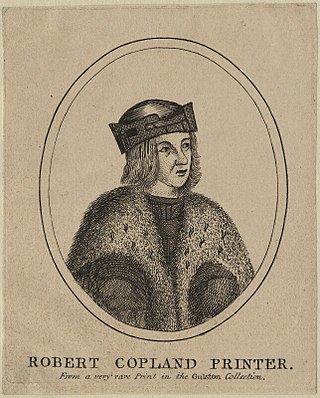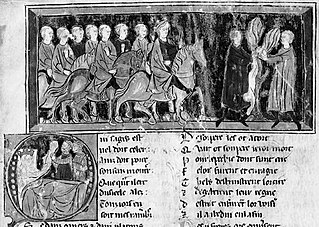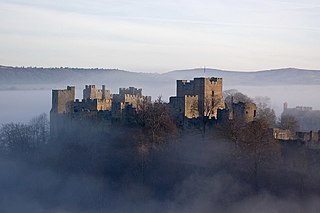Related Research Articles

Marie de France was a poet, likely born in France, who lived in England during the late 12th century. She lived and wrote at an unknown court, but she and her work were almost certainly known at the royal court of King Henry II of England. Virtually nothing is known of her life; both her given name and its geographical specification come from manuscripts containing her works. However, one written description of her work and popularity from her own era still exists. She is considered by scholars to be the first woman known to write francophone verse.
Anglo-Norman literature is literature composed in the Anglo-Norman language and developed during the period of 1066–1204, as the Duchy of Normandy and the Kingdom of England were united in the Anglo-Norman realm.

As a literary genre, the chivalric romance is a type of prose and verse narrative that was popular in the noble courts of high medieval and early modern Europe. They were fantastic stories about marvel-filled adventures, often of a chivalric knight-errant portrayed as having heroic qualities, who goes on a quest. It developed further from the epics as time went on; in particular, "the emphasis on love and courtly manners distinguishes it from the chanson de geste and other kinds of epic, in which masculine military heroism predominates."
The term Middle English literature refers to the literature written in the form of the English language known as Middle English, from the late 12th century until the 1470s. During this time the Chancery Standard, a form of London-based English, became widespread and the printing press regularized the language. Between the 1470s and the middle of the following century there was a transition to early Modern English. In literary terms, the characteristics of the literary works written did not change radically until the effects of the Renaissance and Reformed Christianity became more apparent in the reign of King Henry VIII. There are three main categories of Middle English literature, religious, courtly love, and Arthurian, though much of Geoffrey Chaucer's work stands outside these. Among the many religious works are those in the Katherine Group and the writings of Julian of Norwich and Richard Rolle.

Robert Copland was an English printer and author. He is said to have been a servant of William Caxton, and certainly worked for Wynkyn de Worde. The first book to which his name is affixed as a printer is The Boke of Justices of Peace (1515), at the sign of the Rose Garland, in Fleet Street, London. Anthony à Wood supposed, on the ground that he was more educated than was usual in his trade, that he had been a poor scholar of Oxford.

The Romance of Thebes is a poem of some 10,000 lines that appears to be based on an abridged version of the Thebaid of Statius. This view is supported by the omission of incidents and details which, in spite of the altered conditions under which the poem was composed, would naturally have been preserved in any imitation of the Thebaid, while again certain modifications of the version of Statius can hardly be due to the author's invention but point to an ancient origin.
Fouke le Fitz Waryn is a chivalric romance about the English baron Fulk III FitzWarin, written during the later 13th century, when the actual events of Fulk's life were still in living memory or common report. Probably originally composed in Old French verse, it survives only in an early 14th-century French prose version in a single manuscript in the Royal manuscripts, British Library, which is thought to follow the lost verse quite closely. The 16th-century antiquary John Leland saw and briefly described the French verse version, and made an extended abstract from a Middle English verse version called The Nobile Actes of the Guarines, the original of which is also lost. Various contemporary references show that the tale was widely-known in the later Middle Ages.

Richard Pynson was one of the first printers of English books. Born in Normandy, he moved to London, where he became one of the leading printers of the generation following William Caxton. His books were printed to a high standard of craftsmanship, and his Morton Missal (1500) is regarded as among the finest books printed in England in the period.

The Anglo-Norman invasion of Ireland took place during the late 12th century, when Anglo-Normans gradually conquered and acquired large swathes of land in Ireland over which the monarchs of England then claimed sovereignty. The Anglo-Normans claimed the invasion was sanctioned by the papal bull Laudabiliter. At the time, Gaelic Ireland was made up of several kingdoms, with a High King claiming lordship over most of the other kings. The Anglo-Norman invasion was a watershed in Ireland's history, marking the beginning of more than 800 years of British rule in Ireland.

Johannes de Garlandia or John of Garland was a medieval grammarian and university teacher. His dates of birth and death are unknown, but he probably lived from about 1190 to about 1270.
Ipomedon is a romance composed in Anglo-Norman verse by Hugh of Rhuddlan in the late 12th century at Credenhill near Hereford. In the sequel Protheselaus, which must have been composed slightly later, Hugh acknowledges as his patron Gilbert fitzBaderon, lord of Monmouth. Gilbert's death in or just before 1191 gives an approximate terminus ante quem to both romances.
Protheselaus is a verse romance composed in Anglo-Norman by Hugh of Rhuddlan at the end of the 12th century. Hugh lived at Credenhill near Hereford, according to his earlier poem Ipomedon. Protheselaus is dedicated to Hugh's patron Gilbert fitzBaderon, lord of Monmouth. Gilbert died in or just before 1191: that date is a terminus ante quem for the completion of Protheselaus.

The House of Tosny was an important noble family in 10th and 11th century Normandy, though it did not include any comtes or vicomtes. Its founder was Raoul I of Tosny.

The Normans were a population arising in the medieval Duchy of Normandy from the intermingling between Norse Viking settlers and locals of West Francia. The Norse settlements in West Francia followed a series of raids on the French northern coast mainly from what is now Denmark, although some also sailed from Norway and Sweden. These settlements were finally legitimized when Rollo, a Scandinavian Viking leader, agreed to swear fealty to King Charles III of West Francia following the siege of Chartres in 911. The intermixing in Normandy produced an ethnic and cultural "Norman" identity in the first half of the 10th century, an identity which continued to evolve over the centuries. The Normans adopted the culture and language of the French, while they continued the martial tradition of their Viking ancestors as mercenaries and adventurers. In the 11th century, Normans from the duchy conquered England and southern Italy.

Ipomadon is a Middle English translation of Hugh of Rhuddlan's Anglo-Norman romance Ipomedon composed in tail-rhyme verse, possibly in the last decade of the fourteenth century. It is one of three Middle English renditions of Hugh's work: the other two are a shorter verse Lyfe of Ipomydon and the prose Ipomedon, both of the fifteenth century. Each version is derived independently from the Anglo-Norman Ipomedon, which Hugh wrote 'not long after 1180', possibly in Herefordshire. It is included in a list of the popular English romances by Richard Hyrde in the 1520s.

Pain fitzJohn was an Anglo-Norman nobleman and administrator, one of King Henry I of England's "new men", who owed their positions and wealth to the king.

Josce de Dinan was an Anglo-Norman nobleman who lived during and after the civil war between King Stephen of England and his cousin Matilda over the throne of England. He was a landholder in the Welsh Marches when he was married by Stephen to the widow of Pain fitzJohn, a union that gave Josce control of Ludlow Castle. Control of the castle was contested by other noblemen, and the resulting warfare between the nobles forms the background to a late medieval romance known as Fouke le Fitz Waryn, which is mainly concerned with the actions of Josce's grandson, but also includes some material on Josce's lifetime. Josce eventually lost control of Ludlow and was granted lands in compensation by Matilda and her son, King Henry II of England, who succeeded Stephen in 1154.
Gilbert fitzBaderon of Monmouth was one of the two sons of Baderon fitzWilliam by his wife Rohese de Clare. When Baderon died, at some date between 1170 and 1176, Gilbert succeeded him as lord of Monmouth and holder of Monmouth Castle. Gilbert is best known as a patron of literature and it was under Gilbert's patronage that the poet Hugh of Rhuddlan wrote his verse romance Ipomedon, which was among the most popular works in its genre in medieval England. The original text in Anglo-Norman was translated at least three times into Middle English under the variant title Ipomadon. Hugh afterwards wrote a sequel, Protheselaus, which he dedicated to his patron Gilbert fitzBaderon.
Sybil was an Anglo-Norman noblewoman in 12th-century England. Her parentage is unclear, but her first marriage to Pain fitzJohn is well-attested. Through her marriage, Sybil transferred lands in several shires to her husband, including lands around Ludlow Castle and the castle itself. After Pain's death in 1137, Sybil attempted to retain control of Ludlow and her lands but in 1139 King Stephen of England married her to Josce de Dinan, who died in 1166. Sybil had two daughters with Pain and is probably the mother of Josce's two daughters also. Sybil's marriage to Josce, and his control of Ludlow in right of his wife forms the background to a medieval Welsh romance, Fouke le Fitz Waryn.
William Meschin was an Anglo-Norman nobleman and baron. The brother of the earl of Chester, he participated in the First Crusade. After returning to England, he acquired lands from King Henry I of England and by his marriage to an heiress. He built Egremont Castle on one parcel and with his wife funded two religious foundations. After he died, his estates were divided amongst his three daughter's descendants.
References
- Article Hue de Rotelande by Keith Busby, p. 461 in Medieval France: An Encyclopedia, editor William Westcott Kibler
- Eugen Kölbing (1889), Ipomedon, in drei Englischen Bearbeitungen
- Franz Kluckow (1924), Hue de Rotelande: Protheselaus
- A. J. Holden (1979), Ipomedon: poème de Hue de Rotelande, fin du XIIe siècle
- A. J. Holden editor, Protheselaus by Hue de Rotelande Anglo-Norman Text Society
- Rhiannon Purdie, editor (2001), Ipomadon